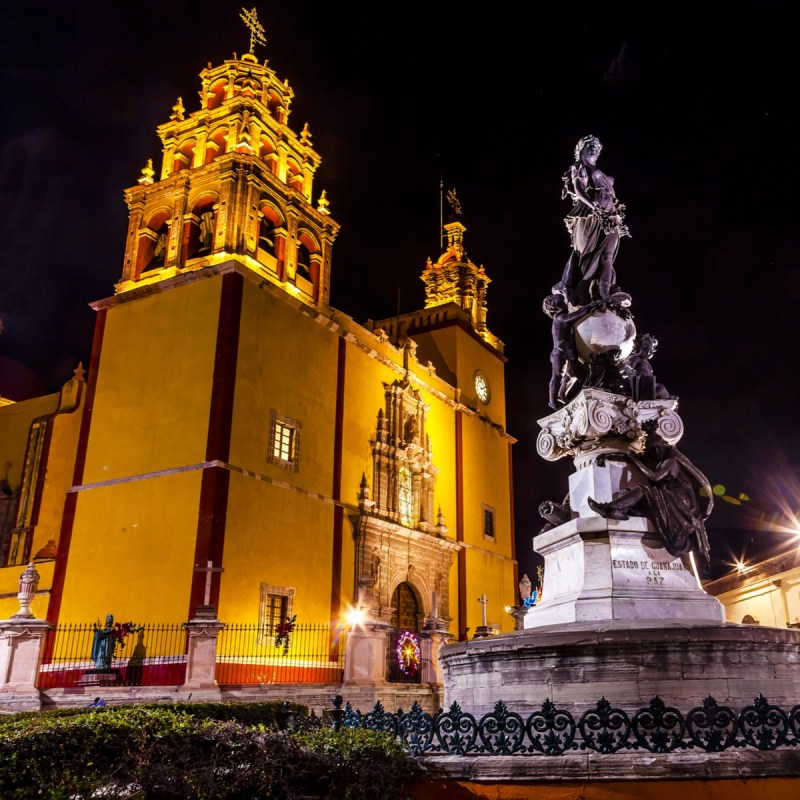
“Hope you’re enjoying your vacation!” a friend wrote to me a few months ago. Over lunch on the patio of our Mexican home, I read her email to Barry, my husband. “Vacation?” he said. “Are you kidding?” Even though our friends know we have lived part-time in the UNESCO World Heritage city of Guanajuato for more than 17 years, many of them still seem to think we spend our days lolling on hammocks and drinking margaritas. Not quite!
Videos by TravelAwaits
Guanajuato is an artist’s dream. A vibrant city built up from a deep ravine, it looks like a wide U, with houses stacked on top of each other the color of mango, watermelon, lemon, and kiwi. But beautiful as it is, living here takes far more effort, initiative, ingenuity, and creativity than in the U.S. Here are six examples:

1. Home Maintenance
In 2005, we bought a 150-year-old adobe house which, thanks to the carved stone cornice on the facade, is an immueble catalogado, Mexico’s equivalent of a building on the historic register. It would have been a lot easier to have bought a home that didn’t involve so much bureaucracy, but we didn’t know that then. Owning our Mexican home has brought us great joy, but with that has come sweat equity and maintenance.
We spent several years remodeling, a lengthy and complicated process requiring a range of specialists, including an architect, two contractors, an electrician, a metal worker, several gardeners, a carpenter, and many albañiles (workers). We now enjoy a comfortable, beautiful home. However, in older Guanajuato adobe homes, maintenance never ends. To take just one example, since most buildings are colindaria (row houses), in the rainy season, moisture can travel through the adobe walls, causing damage to the adjacent houses and tension between neighbors. After several years of sealing the same leaks, our inventive contractor, Juan, came up with a long-term solution. He inserted perforated tubes into the walls of the downstairs rooms, which dried the moisture and reduced leaks.
Newer homes in Guanajuato wouldn’t require as much maintenance, but we fell in love with our home’s unbeatable view and location, which is very central, but also quiet. No regrets!

2. Infrastructure And Modern Conveniences
In the U.S., most houses come equipped with basic appliances like a stove, oven, fridge, dishwasher, and washer and dryer. Not in Mexico. When we bought our home, it had nada — not even a stove or a bathroom mirror. Newer homes on the market are somewhat more equipped, but most foreigners still choose to remodel. Here are some ways the infrastructure takes time and effort:
Washing Clothes And Dishes
We don’t own a dishwasher or dryer for our clothes, so we wash dishes by hand and hang clothes on the roof. This is not a problem! In Mexico’s warm climate, clothes dry fast. Expats who want modern conveniences install the necessary appliances.
Household And Drinking Water
In Mexico, the water piped to the home isn’t drinkable. For household water, a tinaco (large tank of water) on the roof supplies the various water fixtures in our house.
We buy potable water in 5-gallon containers (garafones) hoisted by young men who walk up and down our hilly pedestrian street twice a week. This system can be a bit tricky because we have to be home to order the water and pay the muchacho, and if we miss him, we’re out of luck for 3 days. For this reason, many expats invest in reverse-osmosis filter systems, but these require periodic maintenance, and since we’re not in Guanajuato full-time, we haven’t chosen this option.

Hot Water
Unlike in the U.S., where gas arrives to a home invisibly, most houses in Mexico have a gas tank that needs to be changed periodically. On Guanajuato’s pedestrianized streets, gas is delivered in heavy cylinders on the shoulders of men.
A few years ago we decided to save money on gas by investing in a solar water heater, so our on-demand gas heater is now just for back-up. The solar-heated water gives us the highest-pressure and hottest showers of our lives. We don’t have a bathtub, but a few years ago we brought a fold-up plastic mini-tub down from the States that seats one person at a time. We pour hot water into our tub and enjoy a soak once or twice a week. Our cleaner, Lidia, later repurposes the water to mop the floors and water the plants.
Garbage
In some Guanajuato suburbs, garbage is picked up like in the U.S., but in el centro, where garbage trucks can’t reach alleys, residents carry their garbage to a nearby dumpster, which in our case is located 3 minutes away.
No Car
Like many other expats, we find it much easier living here without a car. Guanajuato is not particularly car-friendly. Most homes don’t have garages or driveways, so you have to pay to keep the car in a parking lot.
Plus, most of the time, driving isn’t necessary. In town, we walk everywhere, and if we take a trip, we use Primera Plus (one of Mexico’s excellent first-class buses), rent a car, or fly, often on Volaris, Mexico’s budget airline.

3. Our Patio
When we bought the house, Barry proposed that instead of replacing one of our crumbling ceilings, we remove it altogether and turn the former bedroom into a garden patio. Most houses in el centro don’t have a garden, so I agreed immediately. The problem? Neither of us knows much about plants in Mexico (or anywhere else for that matter).
While we love our green space, it’s also been an ongoing challenge, especially since we’re not here year-round. Through much trial and error, we’re slowly figuring out which plants work in a semi-desert, dry climate and which do better in sun versus shade. I can’t keep track of the number of visits we’ve made to the vivero (nursery), and all the plant lovers and gardeners we’ve begged, bartered, and paid to give us advice.
I inspect our jardinera (the wall-to-wall plant box) daily, watching the delicate tendrils twine and spiral while the vines climb up the walls. Barry and I talk obsessively about our plants, as though they were our kids.
4. Bureaucracy And Banking
Through our Mexican bank account, we pay most of our utilities electronically. This year we decided to try to automate payments to our cleaner. It wasn’t clear from the bank’s website how to do it, so I left our home early one morning to wait an hour to meet with a banker, a meeting that was cut short because I had forgotten my passport. So back I went the next day for another hour and still didn’t get an answer. Waiting in line is a fact of life in Mexico. And it seems to make no difference which bank you belong to — no expat I’ve met finds their Mexican bank simple.
5. Errands
I shop for food most days on foot. The small shop at the bottom of our street has many of the basics. Other groceries, mom ‘n’ pop shops, bakeries, and coffee shops are located within a few minutes’ walk of our home. I only buy as much as I can carry in my shopping bag. If I forget something, I just go out again later.
Getting things done in Guanajuato is often a very personal process. For example, the other day I woke up to find my watch strap had broken. If this had happened in Eureka, I’d have bought a new watch at Target. Instead, I went to see Rudi, who owns a watch repair workshop. While he outfitted my watch with a new band, I asked him about the family photos on the wall, hearing about his architect wife and three adult children. Such a satisfying, hands-on way to solve a problem.

6. Daily And Weekly Rhythms
Of course, our life in Guanajuato is not all about maintenance and infrastructure! Besides running errands and doing household tasks, I spend my time writing articles for Travel Awaits and other sites, giving editorial feedback to Barry (a science writer), taking Spanish classes, going to yoga, and walking with friends. I also chat with Lidia on Mondays, her cleaning day, when she dusts, sweeps, mops, and takes care of our plants. In Guanajuato’s dry climate, our open-air house accumulates a great deal of dust. Barry and I joke that she’s la jefa (boss) of the house.
On Saturdays, Barry and I often hike, and on Sundays, we bicycle on la Panoramica, the road above town that circumnavigates the city.
We used to belong to a meditation group run by a Japanese teacher, but after COVID forced it to stop, we started sitting quietly for about half an hour most afternoons in one of the city’s vast, ornate 17th-century churches. This has since become one of our favorite activities.
Life in Guanajuato requires some ingenuity and initiative, because solutions don’t come as ready-made as they do in the U.S. But the concrete, immediate way of life here never fails to stimulate me. It sure beats lying in a hammock.
